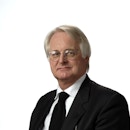- Speaker
-
 Hendrik Lenstra, Ph.D.Professor Emeritus of Fundamental and Applied Mathematics, Mathematisch Instituut, Universiteit Leiden
Hendrik Lenstra, Ph.D.Professor Emeritus of Fundamental and Applied Mathematics, Mathematisch Instituut, Universiteit Leiden
Presidential Lectures are a series of free public colloquia spotlighting groundbreaking research across four themes: neuroscience and autism science, physics, biology, and mathematics and computer science. These curated, high-level scientific talks feature leading scientists and mathematicians and are designed to foster discussion and drive discovery within the New York City research community. We invite those interested in these topics to join us for this weekly lecture series.
In 1956, the Dutch graphic artist M.C. Escher made an unusual lithograph. Titled “Prentententoonstelling” (or, “Print Gallery”), the piece shows a young man standing in an exhibition gallery viewing a print of a Mediterranean seaport. Among the buildings depicted in the twisting print, the man paradoxically sees the very same gallery in which he is standing. Curiously, Escher left the middle of the lithograph blank, filling it with only his monogram and signature.
In this lecture, Hendrik W. Lenstra will discuss interactions between mathematics and M.C. Escher’s artwork. A mathematical analysis of the methods used by Escher leads to a series of hallucinating computer animations that show, among others, what’s in the blurry blank hole in the middle of the piece.
